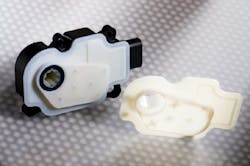Laser-welded plastic component controls airflow in new vehicle engines
BASF and Precision Motors are applying laser welding to create an air flap control unit that will support a new vehicle engine feature designed to adjust airflow to improve efficiency.
A new car engine design invented by Röchling Automotive incorporates controllable air guides, or flap, installed behind the radiator grill, designed to improve engine performance and aerodynamics. Traditional engine design directs airflow to keep the engine cool, but manipulating air flow has advantages: closing these air flaps at high traveling speeds reduces air resistance, which saves fuel, while keeping them closed at start-up helps the engine more quickly ramp to operating temperature and lowers emissions.
To manipulate these air flaps, Precision Motors Deutsche Minebea (PM DM) and Röchling have developed a new control module, consisting of a small actuator with gears, an electric motor, and an electronic unit. (Röchling is integrating and validating the modules for automotive customers.) And the housing cover of this control module is manufactured and laser welded with BASF's Ultradur LUX thermoplastic engineering polymer (polybutylene terephthalate, or PBT), a material used for joining plastics in laser transmission welding.
The material -- in this case, a version reinforced with 20% glass fiber -- achieves laser transparency in the range of 800-1100 nm, letting through much more light than standard PBT compounds, the company notes. (The laser-absorbing black part of the housing is made with BASF's Ultradur S 4090G4, a low-warpage PBT/ASA compound.) The material also possesses stiffness and dimensional stability even in damp environments, important properties for electronics and electric applications. This all translates into faster and more reliable welding, lower risk of material damage, a wider processing window, and greater design freedom.
is made with laser-transparent PBT material, while the laser-absorbing
black component is a low-warpage PBT/ASA compound. (Source: BASF)

